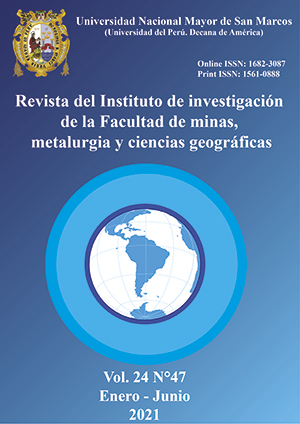Simulation and analysis of floods in water basin heads, using the IBER software in different sections
DOI:
https://doi.org/10.15381/iigeo.v24i47.20637Keywords:
IBER, geomorphology, maximum flows, floods, basin headAbstract
The present study was carried out at the confluence of the Baños, Minascocha and Quilla micro-basins; which belongs to the upper part of the Chancay-Huaral basin, in order to identify the areas of greatest vulnerability to high intensity rainfall phenomena (floods). For the modeling of this section, the flows obtained by means of the SWAT software were used. The flood simulation was carried out using the IBER V2.5 software, which is free software, which is used to simulate floods in shallow waters, that is, shallow waters. The files used were satellite images, DEM files, maximum flows. The Geographic Information Systems were also used: ArcGis 10.5, QGIS 3.8.2, SASPLANET, GLOBALMAPER. The mathematical basis was the two-dimensional equations of St. Venant, which incorporates the turbulence and friction of the flow. The results are shown in three strategic points at the exit of the headwaters of the basin, with cross sections, speed, draft and froude. As results, it is observed that floods are not observed in the headwaters of the basin, the speeds of the water flow decrease as a function of time and distance, due to the confined geomorphological characteristics, the rocky massif, the moraine sediments to leptosols and the herbaceous vegetation - shrubby.
Downloads
Published
Issue
Section
License
Copyright (c) 2021 Francisco Alejandro Alcántara Boza, Clever Torres Rojas, Leonel Rolando Lucas Vidal, Johnny Daniel Bravo Loor

This work is licensed under a Creative Commons Attribution 4.0 International License.
AUTHORS RETAIN THEIR RIGHTS:
a. Authors retain their trade mark rights and patent, and also on any process or procedure described in the article.
b. Authors retain their right to share, copy, distribute, perform and publicly communicate their article (eg, to place their article in an institutional repository or publish it in a book), with an acknowledgment of its initial publication in the Rev. Inst. investig. Fac. minas metal cienc. geogr.
c. Authors retain theirs right to make a subsequent publication of their work, to use the article or any part thereof (eg a compilation of his papers, lecture notes, thesis, or a book), always indicating the source of publication (the originator of the work, journal, volume, number and date).






